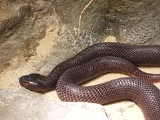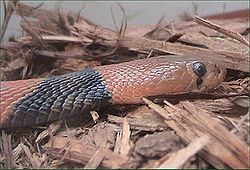
Red Spitting Cobra
Encyclopedia
The Red Spitting Cobra (Naja pallida), is a species of spitting cobra
native to Africa
. This species is one of several spittings cobra in Africa. Spitting cobras do not spit their venom. Instead, they spray their venom to their enemies, and if the venom gets into the eyes, it can cause intense pain and temporary or even permanent blindness
.
, with maximum length of 120 cm (4 ft) and smaller sized specimen of about 60 cm (2 ft) to 75 cm (2 ft 6 in). Body color of this species has great variation from red, deep orange, pale red, pinkish and light brown. Red Spitting Cobras found in Northern Africa have duller color while others are much brighter. There is a black band on the underside of the neck. Like most other spitting cobras, the hood of the Red Spitting Cobra is narrow compared with the Indian Cobra
and the Cape Cobra
. It also has a small round head and a pair of rather large eyes.

and Sudan
. It primarily inhabits dry savanna and semi-desert area. It is quite common to be found in oasis in desert where it hunts.
and cytotoxic
. Bite symptoms include slight pain around the wound and numbness of lips and tongue. Although it rarely causes human death, urgent medical care is required if someone is bitten by this species.
In September 2011, a snake keeper from South Africa
allegedly died shortly after a Red Spitting Cobra sprayed venom into his face whilst he and a friend were photographing the snake. It is believed that some of the venom entered his nasal passages and led to anaphylactic shock.
. The female will lay around 5 to 15 eggs.
than to this species. The Red Spitting Cobra is closely related and forms a sister taxon with the Nubian Spitting Cobra (Naja nubiae) of northern Africa, which was originally considered a northern population of pallida before being recognized as a distinct species in 2003.
Spitting cobra
A spitting cobra is one of several species of cobras that have the ability to eject venom from their fangs when defending themselves against predators. The sprayed venom is harmless to intact skin...
native to Africa
Africa
Africa is the world's second largest and second most populous continent, after Asia. At about 30.2 million km² including adjacent islands, it covers 6% of the Earth's total surface area and 20.4% of the total land area...
. This species is one of several spittings cobra in Africa. Spitting cobras do not spit their venom. Instead, they spray their venom to their enemies, and if the venom gets into the eyes, it can cause intense pain and temporary or even permanent blindness
Blindness
Blindness is the condition of lacking visual perception due to physiological or neurological factors.Various scales have been developed to describe the extent of vision loss and define blindness...
.
Description
This is a relatively small-sized cobraCobra
Cobra is a venomous snake belonging to the family Elapidae. However, not all snakes commonly referred to as cobras are of the same genus, or even of the same family. The name is short for cobra capo or capa Snake, which is Portuguese for "snake with hood", or "hood-snake"...
, with maximum length of 120 cm (4 ft) and smaller sized specimen of about 60 cm (2 ft) to 75 cm (2 ft 6 in). Body color of this species has great variation from red, deep orange, pale red, pinkish and light brown. Red Spitting Cobras found in Northern Africa have duller color while others are much brighter. There is a black band on the underside of the neck. Like most other spitting cobras, the hood of the Red Spitting Cobra is narrow compared with the Indian Cobra
Indian Cobra
Indian Cobra or Spectacled Cobra is a species of the genus Naja found in the Indian subcontinent and a member of the "big four", the four species which inflict the most snakebites in India. This snake is revered in Indian mythology and culture, and is often seen with snake charmers...
and the Cape Cobra
Cape Cobra
The Cape Cobra or yellow cobra is a moderately sized, highly venomous cobra inhabiting a wide variety of biomes across Southern Africa...
. It also has a small round head and a pair of rather large eyes.

Distribution and habitat
The Red Spitting Cobra is mainly found in Eastern Africa, including KenyaKenya
Kenya , officially known as the Republic of Kenya, is a country in East Africa that lies on the equator, with the Indian Ocean to its south-east...
and Sudan
Sudan
Sudan , officially the Republic of the Sudan , is a country in North Africa, sometimes considered part of the Middle East politically. It is bordered by Egypt to the north, the Red Sea to the northeast, Eritrea and Ethiopia to the east, South Sudan to the south, the Central African Republic to the...
. It primarily inhabits dry savanna and semi-desert area. It is quite common to be found in oasis in desert where it hunts.
Behavior
Adults are more commonly found at night while juveniles are active both during day and night. This is a terrestrial, fast and alert snake. When threatened, it rears up and displays a typical cobra hood. It also hisses loudly. If the intruder does not retreat, it may sprays jets of venom to the face of the intruder. Venom that gets into the eyes can cause burning pain and blindness. Even so, this snake seldom bites and causes human death, as this species rarely encounter people due to its habitat and this species is not aggressive.Diet
This species has a wide range of prey, including small mammals, lizards, other snakes, birds and eggs.Venom
This species, like most spitting cobra, contains a mixture of neurotoxicNeurotoxicity
Neurotoxicity occurs when the exposure to natural or artificial toxic substances, which are called neurotoxins, alters the normal activity of the nervous system in such a way as to cause damage to nervous tissue. This can eventually disrupt or even kill neurons, key cells that transmit and process...
and cytotoxic
Cytotoxicity
Cytotoxicity is the quality of being toxic to cells. Examples of toxic agents are a chemical substance, an immune cell or some types of venom .-Cell physiology:...
. Bite symptoms include slight pain around the wound and numbness of lips and tongue. Although it rarely causes human death, urgent medical care is required if someone is bitten by this species.
In September 2011, a snake keeper from South Africa
South Africa
The Republic of South Africa is a country in southern Africa. Located at the southern tip of Africa, it is divided into nine provinces, with of coastline on the Atlantic and Indian oceans...
allegedly died shortly after a Red Spitting Cobra sprayed venom into his face whilst he and a friend were photographing the snake. It is believed that some of the venom entered his nasal passages and led to anaphylactic shock.
Reproduction
The Red Spitting Cobra is oviparousOviparity
Oviparous animals are animals that lay eggs, with little or no other embryonic development within the mother. This is the reproductive method of most fish, amphibians, reptiles, all birds, the monotremes, and most insects, some molluscs and arachnids....
. The female will lay around 5 to 15 eggs.
Taxonomy
This species was formerly considered to be a subspecies, Naja mossambica pallida, of Naja mossambica, but is now categorized as a separate species http://www.kingsnake.com/elapids/red_spitting_cobra.htm. Indeed mossambica is more closely related to N. nigricollisNaja nigricollis
Naja nigricollis is a species of spitting cobra found in Sub Saharan Africa. It is feared throughout its range and has the capability of spraying venom at attackers as a defensive mechanism...
than to this species. The Red Spitting Cobra is closely related and forms a sister taxon with the Nubian Spitting Cobra (Naja nubiae) of northern Africa, which was originally considered a northern population of pallida before being recognized as a distinct species in 2003.

